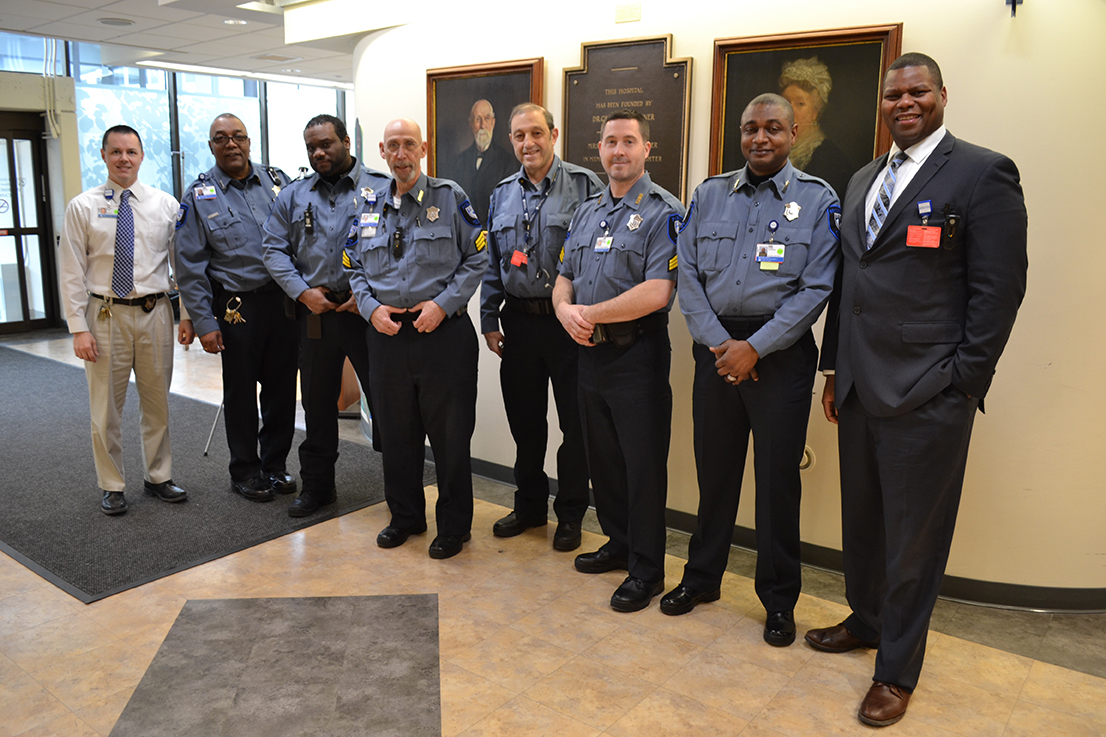Notice of privacy incident at Brigham and Women's Faulkner Hospital Learn More
Header Skipped.
Notice of privacy incident at Brigham and Women's Faulkner Hospital Learn More
Header Skipped.

Security Operations Manager Stewart Prue (far left) and Director of Police, Security, Safety and Parking Terrance Lassiter (far right) with members of the Safety and Security Team
At Brigham and Women’s Faulkner Hospital, staff safety is always a top priority. In fact, it’s part of the hospital’s Strategic Goals. For several years, the Workplace Safety Committee, together with the Police, Security, Safety and Parking Department, has worked towards improving existing Workplace Safety initiatives.
“It’s important that we review our training programs and protocols on a regular basis to ensure we remain diligent when it comes to staff and patient safety,” explains Director of Police, Security, Safety and Parking Terrance Lassiter. “This year, we’re focused on making sure our staff feel safe at work and know what to do should a security situation arise.”
De-Escalation Training Program
De-Escalation Training, provided by the Department of Safety and Security, Nursing Staff Development and the Department of Education, is designed to help staff maintain their own safety through verbal de-escalation and physical restraint skills. These classes, offered as both an all-day initial training session and a half-day recertification training session, are offered on a regular schedule and are taught by experts trained in the AVADE method. Topics covered include trauma informed care, constant observation, use of restraint/seclusion and care of the suicidal patient.
“It’s a great course for all hospital employees, but we highly recommend it for front-line staff,” says Security Operations Manager Stewart Prue. “In fact, it’s our goal this year to have 90 percent of all staff up-to-date on their De-Escalation Training.”
In order to achieve this goal, Prue says he’s made the course schedule, which you can find on BWFHconnect, more consistent and is even offering evening classes and additional courses to groups who can’t make the scheduled dates.
S.A.F.E. Response Program
In November of 2019, BWFH launched an inpatient S.A.F.E. (Spot a threat, Assess the risk, Formulate a safe clinical response and Evaluate the outcome) response to support workplace safety in the hospital’s medical, surgical and ICU units. This tool has been nicknamed “a behavioral RRT” as it brings the nursing supervisor, the security supervisor and the responding clinician to the bedside to huddle with the team and plan interventions for patients whose behavior is escalating.
“We’ve had several S.A.F.E. responses called,” says Prue. “In each case, the S.A.F.E. response brought the right group of people to the patient and we were able to quickly begin working toward a solution to keep both the patient and the caregiver safe.”
Constant Observer Program
“In the hospital setting, we often see patients whose behavior indicates they cannot be left unsupervised,” says Lassiter. “These patients are placed on one-to-one observation for their safety and the safety of the staff caring for them.”
Because the Security staff is often tending to other duties throughout the hospital, the role of constant observer for this patient population often falls to a PCA, mental health worker or contracted workforce. In fiscal year 2019, the Department of Safety and Security was increased by over 20 percent and, in fiscal year 2020, the Department of Safety and Security hopes to add more full-time employees to ease this burden as well collect and audit data to measure staff knowledge of the reasons for one-to-one observation.
“Using our own staff provides a safer environment for both our patients and staff,” explains Lassiter.
Active Shooter Response Plan
Active shooter situations—particularly in hospitals—remain a rare but serious threat and all staff need to have an understanding of BWFH’s active shooter response protocols. Those can be referenced by watching the BWFH Active Shooter Preparedness Training video on HealthStream or reading the hospital’s Active Shooter Plan here: https://hospitalpolicies.ellucid.com/documents/view/4636/25203.
“One hundred percent of hospital staff must be trained on active shooter response,” says Prue. “This year, we’re working on a 30-minute drop-in education session to enhance our efforts. We hope to be able to offer this course on a regular schedule, just like De-Escalation Training.”
Looking for more news from BWFH? Go to News to find articles about health, updates to our programs and services and stories about staff and patients.
Go to News